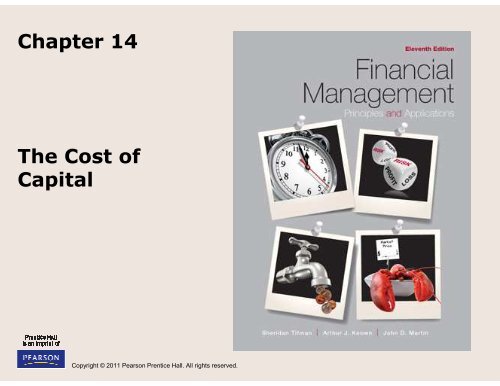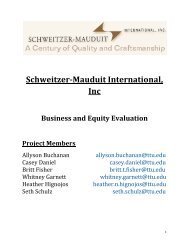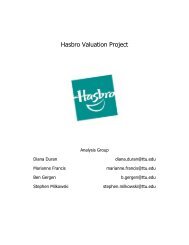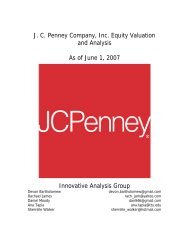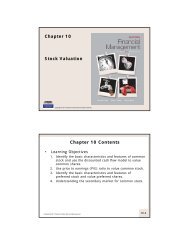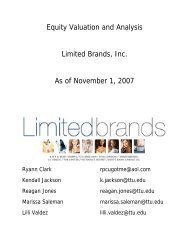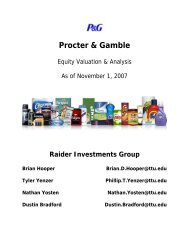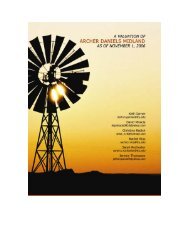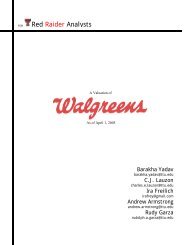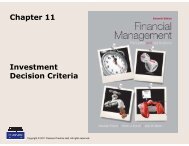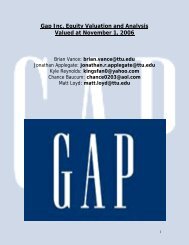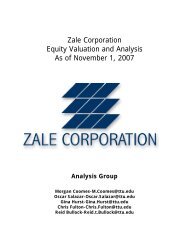The Cost of Capital Chapter 14
The Cost of Capital Chapter 14
The Cost of Capital Chapter 14
You also want an ePaper? Increase the reach of your titles
YUMPU automatically turns print PDFs into web optimized ePapers that Google loves.
<strong>Chapter</strong> <strong>14</strong><strong>The</strong> <strong>Cost</strong> <strong>of</strong><strong>Capital</strong>Copyright © 2011 Pearson Prentice Hall. All rights reserved.
<strong>Chapter</strong> <strong>14</strong> Contents1. <strong>The</strong> <strong>Cost</strong> <strong>of</strong> <strong>Capital</strong>: An Overview2. Determining the Firm’s <strong>Capital</strong> StructureWeights3. Estimating the <strong>Cost</strong>s <strong>of</strong> Individual Sources <strong>of</strong><strong>Capital</strong>4. Summing Up – Calculating the Firm’s WACC5. Estimating Project <strong>Cost</strong> <strong>of</strong> <strong>Capital</strong>6. Floatation costs and Project NPVCopyright © 2011 Pearson Prentice Hall. All rights reserved.<strong>14</strong>-2
Learning Objectives1. Understand the concepts underlying the firm’soverall cost <strong>of</strong> capital and its calculation.2. Evaluate firm’s capital structure, and determinethe relative importance (weight) <strong>of</strong> each source<strong>of</strong> financing.3. Calculate the after-tax cost <strong>of</strong> debt, preferredstock, and common equity.4. Calculate firm’s weighted average cost <strong>of</strong> capital5. Understand: a)Pros and cons <strong>of</strong> using multiple,risk-adjusted discount rates; b)divisional cost <strong>of</strong>capital as alternative for firms with divisions.6. Adjust NPV for the costs <strong>of</strong> issuing new securitieswhen analyzing new investment opportunities.Copyright © 2011 Pearson Prentice Hall. All rights reserved.<strong>14</strong>-3
Principles Used in <strong>Chapter</strong> <strong>14</strong>• Principle #1: Money Has a Time Value.• Principle #3: Cash Flows Are the Source <strong>of</strong> Value.– Estimates <strong>of</strong> investor’s required rate <strong>of</strong> returnextracted from observed market prices arebased on principles #1 and #3.• Principle #2: <strong>The</strong>re Is a Risk-Return Trade<strong>of</strong>f.– Investors who purchase a firm’s common stockrequire a higher expected return than investorswho loan money.Copyright © 2011 Pearson Prentice Hall. All rights reserved.<strong>14</strong>-4
<strong>The</strong> <strong>Cost</strong> <strong>of</strong> <strong>Capital</strong>: An Overview• <strong>The</strong> Firm’s <strong>Cost</strong> <strong>of</strong> capital is the value-weightedaverage <strong>of</strong> the required returns <strong>of</strong> the securitiesthat are used to finance the firm.– Officially refer to this as the firm’s Weighted Average<strong>Cost</strong> <strong>of</strong> <strong>Capital</strong>, or WACC.• Most firms raise capital with a combination <strong>of</strong>debt, equity, and hybrid securities.• WACC incorporates the required rates <strong>of</strong> return <strong>of</strong>the firm’s lenders and investors and the particularmix <strong>of</strong> financing sources that the firm uses.Copyright © 2011 Pearson Prentice Hall. All rights reserved.<strong>14</strong>-5
<strong>The</strong> <strong>Cost</strong> <strong>of</strong> <strong>Capital</strong> Overview (cont.)• How does riskiness <strong>of</strong> firm affect WACC?– Required rate <strong>of</strong> return on securities will be higher if thefirm is riskier.– Risk will influence how the firm chooses to finance i.e.proportion <strong>of</strong> debt and equity.• WACC is useful in a number <strong>of</strong> settings:– WACC is used to value the firm.– WACC is used as a starting point for determining thediscount rate for projects the firm might undertake.– WACC is the appropriate rate to use when evaluatingperformance, specifically whether or not the firm hascreated value for its shareholders.Copyright © 2011 Pearson Prentice Hall. All rights reserved.<strong>14</strong>-6
After-Tax WACC equation (WACC AT )Copyright © 2011 Pearson Prentice Hall. All rights reserved.<strong>14</strong>-7
Copyright © 2011 Pearson Prentice Hall. All rights reserved.<strong>14</strong>-8
3-Step Procedure to Estimate Firm WACC1. Define the firm’s capital structure by determining theweight <strong>of</strong> each source <strong>of</strong> capital. (see column 2, fig <strong>14</strong>-2)2. Estimate the opportunity cost <strong>of</strong> each source <strong>of</strong> financing.We will use the current market value <strong>of</strong> each source <strong>of</strong>capital based on its current, not historical, costs. (seecolumn 3, fig <strong>14</strong>-2)3. Calculate a weighted average <strong>of</strong> the costs <strong>of</strong> each source<strong>of</strong> financing. (see column 4, fig <strong>14</strong>-2)Copyright © 2011 Pearson Prentice Hall. All rights reserved.<strong>14</strong>-9
Copyright © 2011 Pearson Prentice Hall. All rights reserved.<strong>14</strong>-10
Determining Firm’s <strong>Capital</strong> Structure Weights• <strong>The</strong> weights are based on the following sources <strong>of</strong>capital: debt (short-term and long-term),preferred stock and common equity.• Liabilities such as accounts payable and accruedexpenses are not included in capital structure.• Ideally, the weights should be based on observedmarket values. However, not all market valuesmay be readily available.– Hence, we generally use book values for debt andmarket values for equity.Copyright © 2011 Pearson Prentice Hall. All rights reserved.<strong>14</strong>-11
Example 1: Calculating the WACC forTempleton Extended Care Facilities, Inc.In the spring <strong>of</strong> 2010, Templeton was considering the acquisition <strong>of</strong> achain <strong>of</strong> extended care facilities and wanted to estimate its ownWACC as a guide to the cost <strong>of</strong> capital for the acquisition.Templeton’s capital structure consists <strong>of</strong> the following:Copyright © 2011 Pearson Prentice Hall. All rights reserved.<strong>14</strong>-12
Example 1 Continued (Info)Templeton contacted the firm’s investment banker to get estimates<strong>of</strong> the firm’s current cost <strong>of</strong> financing and was told that if the firmwere to borrow the same amount <strong>of</strong> money today, it would have topay lenders 8%. However, given the firm’s 25% tax rate, the aftertaxcost <strong>of</strong> borrowing would only be 6% = 8%(1-.25).Preferred stockholders currently demand a 10% rate <strong>of</strong> return.Common stockholders demand 15% returns.Templeton’s CFO knew that the WACC would be somewhere between6% and 15% since the firm’s capital structure is a blend <strong>of</strong> the threesources <strong>of</strong> capital whose costs are bounded by this range. (Thinkabout the GOOD logic and intuition.)Copyright © 2011 Pearson Prentice Hall. All rights reserved.<strong>14</strong>-13
Computing the Weights - FinallyCopyright © 2011 Pearson Prentice Hall. All rights reserved.<strong>14</strong>-<strong>14</strong>
Example 1 – Solution to WACC ATCopyright © 2011 Pearson Prentice Hall. All rights reserved.<strong>14</strong>-15
Example 2 – Impact <strong>of</strong> <strong>Capital</strong> StructureChange on WACC• After completing her estimate <strong>of</strong> Templeton’s WACC, the CFOdecided to explore the possibility <strong>of</strong> adding more low-costdebt to the capital structure.• With the help <strong>of</strong> the firm’s investment banker, the CFOlearned that Templeton could probably push its use <strong>of</strong> debtto 37.5% <strong>of</strong> the firm’s capital structure by issuing more debtand retiring (purchasing) the firm’s preferred shares.• Assume this could be done without increasing the firm’scosts <strong>of</strong> borrowing or the required rate <strong>of</strong> return demandedby the firm’s common stockholders.• What is your estimate <strong>of</strong> the WACC for Templeton under thisnew capital structure proposal?Copyright © 2011 Pearson Prentice Hall. All rights reserved.<strong>14</strong>-16
Before MV Weight AT Rate W*RDebt 100 0.250 6% 1.500%Preferred 50 0.125 10% 1.250%Common 250 0.625 15% 9.375%Total 400 1.000 WACC 12.125%After MV Weight AT Rate W*RDebt 150 0.375 6% 2.250%Preferred 0 0.000 10% 0.000%Common 250 0.625 15% 9.375%Total 400 1.000 WACC 11.625%Copyright © 2011 Pearson Prentice Hall. All rights reserved.<strong>14</strong>-17
<strong>14</strong>.3 Estimatingthe <strong>Cost</strong> <strong>of</strong>IndividualSources <strong>of</strong> <strong>Capital</strong>Copyright © 2011 Pearson Prentice Hall. All rights reserved.
<strong>The</strong> <strong>Cost</strong> <strong>of</strong> Debt• <strong>The</strong> cost <strong>of</strong> debt is the rate <strong>of</strong> return the firm’slenders demand when they loan money to firm.• <strong>The</strong> rate <strong>of</strong> return is not the same as coupon rate,which is rate contractually set at the time <strong>of</strong> issue.• Can estimate the market’s required rate <strong>of</strong> returnby examining the yield to maturity on firm’s debt.• After-tax cost <strong>of</strong> debt = Yield (1-tax rate)Copyright © 2011 Pearson Prentice Hall. All rights reserved.<strong>14</strong>-19
Example 2: <strong>The</strong> <strong>Cost</strong> <strong>of</strong> Debt Estimate• What will be the yield to maturity on a debt thathas par value <strong>of</strong> $1,000, a coupon interest rate<strong>of</strong> 5%, time to maturity <strong>of</strong> 10 years and iscurrently trading at $900?• What will be the cost <strong>of</strong> debt if tax rate is 30%?• Enter:– N = 10; PV = -900; PMT = 50; FV =1000– I/Y = 6.38%– After-tax cost <strong>of</strong> Debt = Yield (1-tax rate)= 6.38 (1-.3)= 4.47%Copyright © 2011 Pearson Prentice Hall. All rights reserved.<strong>14</strong>-20
<strong>The</strong> <strong>Cost</strong> <strong>of</strong> Debt – Other Approaches• It is not easy to find the market price <strong>of</strong> a specificbond as most bonds do not trade in the publicmarket.• Because <strong>of</strong> this, it is a standard practice toestimate the cost <strong>of</strong> debt using yield to maturityon a portfolio <strong>of</strong> bonds with similar credit ratingand maturity as the firm’s outstanding debt.Copyright © 2011 Pearson Prentice Hall. All rights reserved.<strong>14</strong>-21
Copyright © 2011 Pearson Prentice Hall. All rights reserved.<strong>14</strong>-22
Copyright © 2011 Pearson Prentice Hall. All rights reserved.<strong>14</strong>-23
<strong>Cost</strong> <strong>of</strong> Preferred Equity Estimates• <strong>The</strong> cost <strong>of</strong> preferred equity is the rate <strong>of</strong>return investors require <strong>of</strong> the firm when theypurchase its preferred stock.• <strong>The</strong> cost is not adjusted for taxes sincedividends are paid to preferred stockholdersout <strong>of</strong> after-tax income.Copyright © 2011 Pearson Prentice Hall. All rights reserved.<strong>14</strong>-24
Example: Estimate <strong>Cost</strong> <strong>of</strong> Preferred Equity• Consider the preferred shares <strong>of</strong> Relay Companythat are trading at $25 per share. What will bethe cost <strong>of</strong> preferred equity if these stocks have apar value <strong>of</strong> $35 and pay annual dividend <strong>of</strong> 4%?• k ps = $1.40 ÷ $25 = .056 or 5.6%Copyright © 2011 Pearson Prentice Hall. All rights reserved.<strong>14</strong>-25
<strong>Cost</strong> <strong>of</strong> Common Equity Estimates• <strong>The</strong> cost <strong>of</strong> common equity is the rate <strong>of</strong> returninvestors expect to receive from investing infirm’s stock. This return comes in the form <strong>of</strong>cash distributions <strong>of</strong> dividends and cash proceedsfrom the sale <strong>of</strong> the stock.• <strong>Cost</strong> <strong>of</strong> common equity is harder to estimate sincecommon stockholders do not have a contractuallydefined return (unlike bonds or preferred stock).• <strong>The</strong>re are two approaches to estimating the cost<strong>of</strong> common equity:– Dividend growth model (chapter 10)– CAPM (chapter 8)Copyright © 2011 Pearson Prentice Hall. All rights reserved.<strong>14</strong>-26
<strong>The</strong> Dividend Growth Model – DiscountedCash Flow Approach• Using this approach, estimate the expectedstream <strong>of</strong> dividends as the source <strong>of</strong> futureestimated cash flows.• Use the estimated dividends and current stockprice to calculate the internal rate <strong>of</strong> return on thestock investment. This return is used as anestimate <strong>of</strong> cost <strong>of</strong> equity.• Essentially, cost <strong>of</strong> equity is the I/Y that supportscurrent stock price and our dividend forecastassumptionsCopyright © 2011 Pearson Prentice Hall. All rights reserved.<strong>14</strong>-27
Copyright © 2011 Pearson Prentice Hall. All rights reserved.<strong>14</strong>-28
Step 1: Picture the Problem• We are given the following:– Price <strong>of</strong> common stock (P cs ) = $10.09– Growth rate <strong>of</strong> dividends (g) = 5% and 7.81%– Dividend (D 0 ) = $0.47 per share– <strong>Cost</strong> <strong>of</strong> equity is given by dividend yield +growth rate.Copyright © 2011 Pearson Prentice Hall. All rights reserved.<strong>14</strong>-29
Step 1: Picture the Problem (cont.)Dividend Yield Growth<strong>Cost</strong> <strong>of</strong>=D 1 ÷ P 0 Rate (g) Equity (k cs )Copyright © 2011 Pearson Prentice Hall. All rights reserved.<strong>14</strong>-30
Step 3: Solve• At growth rate <strong>of</strong> 5%• k cs = {$0.47(1.05)/$10.09} + .05= .0989 or 9.89%Copyright © 2011 Pearson Prentice Hall. All rights reserved.<strong>14</strong>-31
Step 3: Solve (cont.)• At growth rate <strong>of</strong> 7.81%• k cs = {$0.47(1.0781)/$10.09} + .0781= .1283 or 12.83 %Copyright © 2011 Pearson Prentice Hall. All rights reserved.<strong>14</strong>-32
Estimating the Rate <strong>of</strong> Growth, g• <strong>The</strong> growth rate can be obtained from variouswebsites that post analysts forecasts <strong>of</strong> growthrates.• We can also estimate the growth rate using thehistorical data and computing the arithmeticaverage or geometric average.Copyright © 2011 Pearson Prentice Hall. All rights reserved.<strong>14</strong>-33
Estimating the Rate <strong>of</strong> Growth, g (cont.)Copyright © 2011 Pearson Prentice Hall. All rights reserved.<strong>14</strong>-34
Pros and Cons <strong>of</strong> the DividendGrowth Model Approach• While dividend growth model is easy touse, it is severely dependent upon thequality <strong>of</strong> growth rate estimates.– When you look at real dividend policies, youwill see that dividends don’t grow smoothly butare a “stair-stepped” function.– This means using smooth g-functionsystematically over and under estimates anygiven future dividend• Furthermore, not all firms pay dividends.Copyright © 2011 Pearson Prentice Hall. All rights reserved.<strong>14</strong>-35
<strong>The</strong> <strong>Capital</strong> Asset Pricing Model• CAPM was used to determine the expected orrequired rate <strong>of</strong> return for risky investments.• Previous Equation illustrates that the expected return oncommon stock is determined by three key ingredients:– <strong>The</strong> risk-free rate <strong>of</strong> interest,– <strong>The</strong> beta or systematic risk <strong>of</strong> the common stock returns,– <strong>The</strong> market risk premium.Copyright © 2011 Pearson Prentice Hall. All rights reserved.<strong>14</strong>-36
Advantages <strong>of</strong> the CAPM approach1. <strong>The</strong> model is simple to understand and use.2. <strong>The</strong> model does not depend on dividends orgrowth rate so it can be applied to companiesthat do not currently pay dividends or are notexpected to experience a constant rate <strong>of</strong> growthin dividends.Copyright © 2011 Pearson Prentice Hall. All rights reserved.<strong>14</strong>-37
Disadvantages <strong>of</strong> the CAPM Approach1. CAPM does not <strong>of</strong>fer any guidance on theappropriate choice for the risk-free rate. Risk-freerate may vary widely depending on the Treasurysecurity chosen.2. Estimates <strong>of</strong> beta can vary widely depending uponthe market index and time period chosen.3. Estimates <strong>of</strong> market risk premium will also varydepending on the time period and securitychosen.Copyright © 2011 Pearson Prentice Hall. All rights reserved.<strong>14</strong>-38
Example: Estimating <strong>Cost</strong> <strong>of</strong> CommonEquity using the CAPMAt the end <strong>of</strong> March 2009, the 10-year U.S. Treasury Bondyield that we will use to measure the risk-free rate was 2.81%Estimated market risk premium at the time is 6.5%, and thebeta for Pearson’s common stock is 1.20Determine Pearson’s cost <strong>of</strong> common equity using the CAPM, as<strong>of</strong> March 2009.K e = R f + Beta * MRP= 2.81% + 1.2*6.5%= 2.81% + 7.8%= 10.61%Copyright © 2011 Pearson Prentice Hall. All rights reserved.<strong>14</strong>-39


